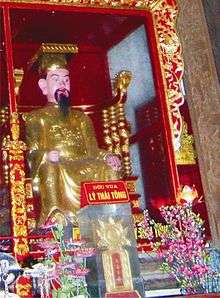Lý Thái Tông
| Lý Thái Tông | |||||||||||||||||
|---|---|---|---|---|---|---|---|---|---|---|---|---|---|---|---|---|---|
| Emperor of Đại Cồ Việt | |||||||||||||||||
 A statue of emperor Lý Thái Tông | |||||||||||||||||
| Emperor of Đại Cồ Việt | |||||||||||||||||
| Reign | 1/4/1028–3/11/1054 | ||||||||||||||||
| Predecessor | Lý Thái Tổ | ||||||||||||||||
| Successor | Lý Thánh Tông | ||||||||||||||||
| Emperor of Lý Dynasty | |||||||||||||||||
| Reign | 1/4/1028–3/11/1054 | ||||||||||||||||
| Predecessor | Lý Thái Tổ | ||||||||||||||||
| Successor | Lý Thánh Tông | ||||||||||||||||
| Born |
973 Duyên Ninh pagoda, Ninh Bình province | ||||||||||||||||
| Died |
1028 (aged 55) Thăng Long, Đại Cồ Việt | ||||||||||||||||
| Burial | Thọ Tomb | ||||||||||||||||
| Spouse |
Empress Linh Cảm (Mai thị) (靈感皇后枚氏). Vương hoàng hậu (王皇后). Đinh hoàng hậu (丁皇后). Thiên Cảm hoàng hậu (天感皇后). | ||||||||||||||||
| Issue |
Crown prince Lý Nhật Tôn [李日尊] as emperor Lý Thánh Tông Duke of Phụng Càn Lý Nhật Trung(奉乾王 李日中) Princess Bình Dương(平陽公主) Princess Trường Ninh(長寧公主) Princess Kim Thành (慶城公主) | ||||||||||||||||
| |||||||||||||||||
| House | Lý | ||||||||||||||||
| Father | Lý Thái Tổ | ||||||||||||||||
| Mother | Empress Linh Hiển | ||||||||||||||||
| Religion | Buddhism | ||||||||||||||||
Lý Thái Tông (chữ Hán: 李太宗) (1000–1054) was the posthumous title of Lý Phật Mã (李佛瑪), emperor of the Lý dynasty of Đại Việt (now Vietnam) from 1028 to 1054.
Biography
His father was Lý Thái Tổ, the founder and the first emperor of the Lý Dynasty. During his reign, he built the basic bureaucratic infrastructure for the dynasty and was considered one of the greatest kings and emperors in Vietnamese history.
At the beginning of his reign, Thái Tông relied mostly on his father's advisers who were left to him and together they crushed a rebellion led by two of his brothers challenging his throne. Later, he personally led an army to defeat yet another unsatisfied brother.
When his rule became more secure, Thái Tông started to demonstrate his unconventional style of governing. He promoted one of his favorite concubines to royal status. He rejected his officials' advice and plowed the land himself during the spring plowing ceremony.
In 1039, Thái Tông had a serious discussion with his official about whether a good government depended upon strong personal leadership or a sophisticated institution. In the end, he accepted his officials' opinion and started to reform the government.
One of those reforms was to reorganize the royal family and make it into a parallel of the government, which was a bureaucratic system. Another significant reform was the publication of a new law, which replaced the old law that was either copied or borrowed from Tang China.
In 1044, Thái Tông with his army invaded Champa. The war was won and the Cham king, Jaya Sinhavarman II, was killed. The amount of the plunder was considerable.[1]:60
Starting around 1049, Thái Tông became less occupied with worldly affairs. He began to seek solutions of life through religion. He died in 1054 and a few months before his death, he transferred the governing job to his son Lý Nhật Tôn (Lý Thánh Tông). The succession went much smoother than the one in 1028 and proved the success of Thái Tông’s institutional reform.
References
- Tarling, Nicholas ed., The Cambridge History of Southeast Asia Volume One, Part One. Cambridge, UK: Cambridge University Express, 1999. 0 521 35505 2
| Preceded by Lý Thái Tổ |
Emperor of the Lý dynasty 1028–1054 |
Succeeded by Lý Thánh Tông |
| Lý royal family (notable members) | |||||||||||||||||||||||||||||||||||||||||||||||||||||||||||||||||||||||||||||||||||||||||||||||||||||||||||||||||||||||||||||||||||||||||||||||||||||||||||||||||||||||||||||||||||||||||||||||||||||||||||||||||||||||||||||||||||||||||||||||||||||||||||||||||||||||||||||||||||||||||||||||||||||||||||||||||||||||||||||||||||||||||||||||||||||||||||||||||||||||||||||||||||||||||||||||||||||||||||||||||||||||||||||||||||||||||||||||||||||||||||||||||||||||||||||||||||||||||||||||||||||||||||||||||||||||||||||||||||||||||||||||||||||||||||||||||||||||||||||||||||||||||||||||||||||||||||||||||||||||||||||||||||||||||||||||||||||||||||||||||||||||||||||||||||||||||||||||||||||||||||||||||||||||||||||||||||||||||||||||||||||||||||||||||||||||||||||||||||||||||||||||||||||||||||||||||||||||||||||||||||||||||||||||||||||||||||||||||||||||||||||||||||||||||||||||||||||||||||||||||||||||||||||||||||||||||||||||||||||||||||||||||||||||||||||||||||||||||||||||||||||||||||||||||||||||||||||||||||||||
|---|---|---|---|---|---|---|---|---|---|---|---|---|---|---|---|---|---|---|---|---|---|---|---|---|---|---|---|---|---|---|---|---|---|---|---|---|---|---|---|---|---|---|---|---|---|---|---|---|---|---|---|---|---|---|---|---|---|---|---|---|---|---|---|---|---|---|---|---|---|---|---|---|---|---|---|---|---|---|---|---|---|---|---|---|---|---|---|---|---|---|---|---|---|---|---|---|---|---|---|---|---|---|---|---|---|---|---|---|---|---|---|---|---|---|---|---|---|---|---|---|---|---|---|---|---|---|---|---|---|---|---|---|---|---|---|---|---|---|---|---|---|---|---|---|---|---|---|---|---|---|---|---|---|---|---|---|---|---|---|---|---|---|---|---|---|---|---|---|---|---|---|---|---|---|---|---|---|---|---|---|---|---|---|---|---|---|---|---|---|---|---|---|---|---|---|---|---|---|---|---|---|---|---|---|---|---|---|---|---|---|---|---|---|---|---|---|---|---|---|---|---|---|---|---|---|---|---|---|---|---|---|---|---|---|---|---|---|---|---|---|---|---|---|---|---|---|---|---|---|---|---|---|---|---|---|---|---|---|---|---|---|---|---|---|---|---|---|---|---|---|---|---|---|---|---|---|---|---|---|---|---|---|---|---|---|---|---|---|---|---|---|---|---|---|---|---|---|---|---|---|---|---|---|---|---|---|---|---|---|---|---|---|---|---|---|---|---|---|---|---|---|---|---|---|---|---|---|---|---|---|---|---|---|---|---|---|---|---|---|---|---|---|---|---|---|---|---|---|---|---|---|---|---|---|---|---|---|---|---|---|---|---|---|---|---|---|---|---|---|---|---|---|---|---|---|---|---|---|---|---|---|---|---|---|---|---|---|---|---|---|---|---|---|---|---|---|---|---|---|---|---|---|---|---|---|---|---|---|---|---|---|---|---|---|---|---|---|---|---|---|---|---|---|---|---|---|---|---|---|---|---|---|---|---|---|---|---|---|---|---|---|---|---|---|---|---|---|---|---|---|---|---|---|---|---|---|---|---|---|---|---|---|---|---|---|---|---|---|---|---|---|---|---|---|---|---|---|---|---|---|---|---|---|---|---|---|---|---|---|---|---|---|---|---|---|---|---|---|---|---|---|---|---|---|---|---|---|---|---|---|---|---|---|---|---|---|---|---|---|---|---|---|---|---|---|---|---|---|---|---|---|---|---|---|---|---|---|---|---|---|---|---|---|---|---|---|---|---|---|---|---|---|---|---|---|---|---|---|---|---|---|---|---|---|---|---|---|---|---|---|---|---|---|---|---|---|---|---|---|---|---|---|---|---|---|---|---|---|---|---|---|---|---|---|---|---|---|---|---|---|---|---|---|---|---|---|---|---|---|---|---|---|---|---|---|---|---|---|---|---|---|---|---|---|---|---|---|---|---|---|---|---|---|---|---|---|---|---|---|---|---|---|---|---|---|---|---|---|---|---|---|---|---|---|---|---|---|---|---|---|---|---|---|---|---|---|---|---|---|---|---|---|---|---|---|---|---|---|---|---|---|---|---|---|---|---|---|---|---|---|---|---|---|---|---|---|---|---|---|---|---|---|---|---|---|---|---|---|---|---|---|---|---|---|---|---|---|---|---|---|---|---|---|---|---|---|---|---|---|---|---|---|---|---|---|---|---|---|---|---|---|---|---|---|---|---|---|---|---|---|---|---|---|---|---|---|---|---|---|---|---|---|---|---|---|---|---|---|---|---|---|---|---|---|---|---|---|---|---|---|---|---|---|---|---|---|---|---|---|---|---|---|---|---|---|---|---|---|---|---|---|---|---|---|---|---|---|---|---|---|---|---|---|---|---|---|---|---|---|---|---|---|---|---|---|---|---|---|---|---|---|---|---|---|---|---|---|---|---|---|---|---|---|---|---|---|---|---|---|---|---|---|---|---|---|---|---|---|---|---|---|---|---|---|---|---|---|---|---|---|---|---|---|---|---|---|---|---|---|---|---|---|---|---|---|---|---|---|---|---|---|---|---|---|---|---|---|---|---|---|---|---|---|---|---|---|---|---|---|---|---|---|---|---|---|---|---|---|---|---|---|---|---|---|---|---|---|---|---|---|---|---|---|---|---|---|---|---|---|---|---|---|---|---|---|---|---|---|---|---|---|---|---|---|---|---|---|---|---|---|---|---|---|---|---|---|---|---|---|---|---|---|---|---|---|---|---|---|---|---|---|---|---|---|---|---|---|---|---|---|---|---|---|---|---|---|---|---|---|
| |||||||||||||||||||||||||||||||||||||||||||||||||||||||||||||||||||||||||||||||||||||||||||||||||||||||||||||||||||||||||||||||||||||||||||||||||||||||||||||||||||||||||||||||||||||||||||||||||||||||||||||||||||||||||||||||||||||||||||||||||||||||||||||||||||||||||||||||||||||||||||||||||||||||||||||||||||||||||||||||||||||||||||||||||||||||||||||||||||||||||||||||||||||||||||||||||||||||||||||||||||||||||||||||||||||||||||||||||||||||||||||||||||||||||||||||||||||||||||||||||||||||||||||||||||||||||||||||||||||||||||||||||||||||||||||||||||||||||||||||||||||||||||||||||||||||||||||||||||||||||||||||||||||||||||||||||||||||||||||||||||||||||||||||||||||||||||||||||||||||||||||||||||||||||||||||||||||||||||||||||||||||||||||||||||||||||||||||||||||||||||||||||||||||||||||||||||||||||||||||||||||||||||||||||||||||||||||||||||||||||||||||||||||||||||||||||||||||||||||||||||||||||||||||||||||||||||||||||||||||||||||||||||||||||||||||||||||||||||||||||||||||||||||||||||||||||||||||||||||||
Notes:
| |||||||||||||||||||||||||||||||||||||||||||||||||||||||||||||||||||||||||||||||||||||||||||||||||||||||||||||||||||||||||||||||||||||||||||||||||||||||||||||||||||||||||||||||||||||||||||||||||||||||||||||||||||||||||||||||||||||||||||||||||||||||||||||||||||||||||||||||||||||||||||||||||||||||||||||||||||||||||||||||||||||||||||||||||||||||||||||||||||||||||||||||||||||||||||||||||||||||||||||||||||||||||||||||||||||||||||||||||||||||||||||||||||||||||||||||||||||||||||||||||||||||||||||||||||||||||||||||||||||||||||||||||||||||||||||||||||||||||||||||||||||||||||||||||||||||||||||||||||||||||||||||||||||||||||||||||||||||||||||||||||||||||||||||||||||||||||||||||||||||||||||||||||||||||||||||||||||||||||||||||||||||||||||||||||||||||||||||||||||||||||||||||||||||||||||||||||||||||||||||||||||||||||||||||||||||||||||||||||||||||||||||||||||||||||||||||||||||||||||||||||||||||||||||||||||||||||||||||||||||||||||||||||||||||||||||||||||||||||||||||||||||||||||||||||||||||||||||||||||||